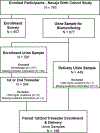Exposure to uranium and co-occurring metals among pregnant Navajo women
- PMID: 32750552
- PMCID: PMC7530024
- DOI: 10.1016/j.envres.2020.109943
Exposure to uranium and co-occurring metals among pregnant Navajo women
Abstract
Navajo Nation residents are at risk for exposure to uranium and other co-occurring metals found in abandoned mine waste. The Navajo Birth Cohort Study (NBCS) was initiated in 2010 to address community concerns regarding the impact of chronic environmental exposure to metals on pregnancy and birth outcomes. The objectives of this paper were to 1) evaluate maternal urine concentrations of key metals at enrollment and delivery from a pregnancy cohort; and 2) compare the NBCS to the US general population by comparing representative summary statistical values. Pregnant Navajo women (N = 783, age range 14-45 years) were recruited from hospital facilities on the Navajo Nation during prenatal visits and urine samples were collected by trained staff in pre-screened containers. The U.S. Centers for Disease Control and Prevention (CDC), National Center for Environmental Health's (NCEH) Division of Laboratory Sciences (DLS) analyzed urine samples for metals. Creatinine-corrected urine concentrations of cadmium decreased between enrollment (1st or 2nd trimester) and delivery (3rd trimester) while urine uranium concentrations were not observed to change. Median and 95th percentile values of maternal NBCS urine concentrations of uranium, manganese, cadmium, and lead exceeded respective percentiles for National Health and Nutrition Evaluation Survey (NHANES) percentiles for women (ages 14-45 either pregnant or not pregnant.) Median NBCS maternal urine uranium concentrations were 2.67 (enrollment) and 2.8 (delivery) times greater than the NHANES median concentration, indicating that pregnant Navajo women are exposed to metal mixtures and have higher uranium exposure compared to NHANES data for women. This demonstrates support for community concerns about uranium exposure and suggests a need for additional analyses to evaluate the impact of maternal metal mixtures exposure on birth outcomes.
Keywords: Maternal biomonitoring; Metal mixtures; Metals; Navajo birth cohort study; Uranium; Urine.
Copyright © 2020 Elsevier Inc. All rights reserved.
Conflict of interest statement
6. CONFLICT OF INTEREST
The authors declare no conflict of interest
Figures




References
-
- Safe Drinking Water Act of 1974. United States: 40 C.F.R.
-
- Arbuckle TE; Liang CL; Morisset A-S; Fisher M; Weiler H; Cirtiu CM; Legrand M; Davis K; Ettinger AS; Fraser WD Maternal and fetal exposure to cadmium, lead, manganese and mercury: the MIREC study. Chemosphere 2016;163:270–282 - PubMed
-
- ATSDR. Toxicological profile for cadmium. Atlanta, GA: U.S. Department of Health and Human Services, Public Health Service, Agency for Toxic Substances and Disease Registry; 2012 - PubMed
-
- Bačeva K; Stafilov T; Šajn R; Tănăselia C; Makreski P Distribution of chemical elements in soils and stream sediments in the area of abandoned Sb–As–Tl Allchar mine, Republic of Macedonia. Environmental research 2014;133:77–89 - PubMed
Publication types
MeSH terms
Substances
Grants and funding
LinkOut - more resources
Full Text Sources

